Scenario Analysis of Air Quality Improvement in Warsaw, Poland, by the End of the Current Decade
Abstract
:1. Introduction
2. Methods
3. Air Pollution in the Baseline Year
4. Projected Decarbonization Modernization
4.1. Official Plans and Scenarios Considered
- Baseline share of main emission categories (2018 emission dataset),
- Reduction in the area emission from municipal sector, due to regulations on the limit on coal fired installations in Warsaw and vicinity, and the national level act on fuel mix decarbonization (horizon 2030)—Section 4.2,
- On top of B, imposing the restrictive emission standard for the car fleet in Warsaw (to E4 norm at least) and taking into account the forecasted increase in the share of electric cars (horizon 2030)—Section 4.3.
4.2. Municipal Sector Modernization
4.3. Urban Transport Modernization
5. Comparative Simulation Results
6. Discussion
7. Conclusions
Supplementary Materials
Author Contributions
Funding
Institutional Review Board Statement
Informed Consent Statement
Acknowledgments
Conflicts of Interest
References
- EEA. Europe’s Air Quality Status 2022. Available online: https://www.eea.europa.eu/publications/status-of-air-quality-in-Europe-2022/europes-air-quality-status-2022 (accessed on 12 March 2021).
- EC. Urban Air Pollution—What Are the Main Sources across the World? 2015. Available online: https://ec.europa.eu/jrc/en/news/what-are-main-sources-urban-air-pollution (accessed on 12 March 2021).
- EC. Air Quality: Traffic Measures Could Effectively Reduce NO2 Concentrations by 40% in Cities. 2019. Available online: https://ec.europa.eu/jrc/en/news/air-quality-traffic-measures-could-effectively-reduce-no2-concentrations-40-europe-s-cities (accessed on 12 March 2021).
- EEA. Exceedance of Air Quality Standard in Europe. 2018. Available online: https://www.eea.europa.eu/ims/exceedance-of-air-quality-standards (accessed on 12 March 2021).
- ETC/ATNI Report 2019/9. European Air Quality Maps for 2017. 2019. Available online: https://www.academia.edu/77543868/ETC_ATNI_Report_2019_9_European_air_quality_maps_for_2017_PM10_PM2_5_Ozone_NO2_and_NOx_spatial_estimates_and_their_uncertainties (accessed on 12 March 2021).
- WHO. WHO Global Air Quality Guidelines. 2021. Available online: https://apps.who.int/iris/handle/10665/345329 (accessed on 12 March 2021).
- WHO. Ambient (Outdoor) Air Pollution. 2018. Available online: https://www.who.int/news-room/fact-sheets/detail/ambient-(outdoor)-air-quality-and-health (accessed on 12 March 2021).
- AIR8. Most Polluted Cities in Europe in 2021. Available online: https://air8.tech/most-polluted-cities-in-europe-in-2021/ (accessed on 12 March 2021).
- ISGlobal—Ranking of Cities. 2021. Available online: https://isglobalranking.org/ranking/#air (accessed on 12 March 2021).
- EEA. Report, No 10/2019. Air Quality in Europe—2019 Report. Available online: https://www.eea.europa.eu/publications/air-quality-in-europe-2019 (accessed on 20 July 2021).
- EEA. Report 2020. Available online: https://www.eea.europa.eu/publications/air-quality-in-europe-2020-report (accessed on 15 September 2021).
- EEA. Air Quality in Europe 2021. Available online: https://www.eea.europa.eu/publications/air-quality-in-europe-2021 (accessed on 20 September 2021).
- GIOS. Yearly Assessment of Air Quality in the Mazovian Voivodship. Report for the Year 2018. 2019. Available online: https://powietrze.gios.gov.pl/pjp/rwms/publications/card/3 (accessed on 20 September 2021). (In Polish)
- GIOS. Yearly Assessment of Air Quality in the Mazovian Voivodship. Report for the Year 2019. 2020. Available online: https://powietrze.gios.gov.pl/pjp/rwms/publications/card/1162 (accessed on 20 September 2021). (In Polish)
- GIOS. Yearly Assessment of Air Quality in the Mazovian Voivodship. Report for the Year 2020. 2021. Available online: https://powietrze.gios.gov.pl/pjp/rwms/publications/card/1421 (accessed on 20 September 2021). (In Polish)
- FIT55. EU Fit for 55 Package. 2021. Available online: https://europeanclimate.org/the-fit-for-55-package/ (accessed on 15 May 2022).
- EC. EU Green Deal. 2019. Available online: https://ec.europa.eu/info/strategy/priorities-2019-2024/european-green-deal_en (accessed on 15 May 2022).
- EC. 2021. Available online: https://ec.europa.eu/clima/eu-action/european-green-deal/2030-climate-target-plan_en (accessed on 15 May 2022).
- EC. The 8th Environment Action Programme till 2030. Decision (EU) 2022/591 of the European Parliament. 2022. Available online: http://data.europa.eu/eli/dec/2022/591/oj (accessed on 15 May 2022).
- Energy. Electricity Sources in Poland in 2020. 2021. Available online: https://wysokienapiecie.pl/35619-zrodla-energii-w-polsce-w-2020-mniej-wegla-wiecej-gazu-oze/ (accessed on 15 May 2022).
- FIT55 2022. Will the Polish RES Target Be Consistent with the EU Climate Policy? Available online: https://instrat.pl/fit-for-55/ (accessed on 15 May 2022).
- Energy 2022. Polityka Energetyczna Polski do 2040 r. Available online: https://bip.mos.gov.pl/strategie-plany-programy/polityka-energetyczna-polski-do-2040-r/ (accessed on 15 May 2022).
- MP 2021. Monitor Polski. Announcement (2.03.2021) of the Minister of Climate and Environment on Poland’s Energy Policy until 2040. Available online: https://www.gov.pl/web/climate/energy-policy-of-poland-until-2040-epp2040 (accessed on 15 May 2022).
- Bogacki, M.; Oleniacz, R.; Rzeszutek, M.; Bździuch, P.; Szulecka, A.; Gorzelnik, T. Assessing the Impact of Road Traffic Reorganization on Air Quality: A Street Canyon Case Study. Atmosphere 2020, 11, 695. [Google Scholar] [CrossRef]
- Juda-Rezler, K.; Reizer, M.; Maciejewska, K.; Błaszczak, B.; Klejnowski, K. Characterization of atmospheric PM2.5 sources at a Central European urban background site. Sci. Total Environ. 2020, 713, 136729. [Google Scholar] [CrossRef] [PubMed]
- Holnicki, P.; Tainio, M.; Kałuszko, A.; Nahorski, Z. Burden of mortality and disease attributable to multiple air pollutants in Warsaw, Poland. Int. J. Environ. Res. Public Health 2017, 14, 1359. [Google Scholar] [CrossRef] [PubMed] [Green Version]
- Holnicki, P.; Nahorski, Z.; Kałuszko, A. Impact of car fleet modernization on the traffic originated air pollution in an urban area—Case study. Atmosphere 2021, 12, 1581. [Google Scholar] [CrossRef]
- Degraeuwe, B.; Thunis, P.; Clappier, A.; Weiss, M.; Lefebvre, W.; Janssen, S.; Vranckx, S. Impact of passenger car NOx emissions on urban NO2 pollution—Scenario analysis for 8 European cities. Atmos. Environ. 2017, 171, 330–337. [Google Scholar] [CrossRef]
- Degraeuwe, B.; Pisoni, E.; Peduzzi, E.; De Meij, A.; Monforti-Ferrario, F.; Bodis, K.; Mascherpa, A.; Astorga-Llorens, M.; Thunis, P.; Vignati, E. Urban NO2 Atlas (EUR 29943 EN); Publications Office of the European Union: Luxembourg, 2019. [Google Scholar]
- Tezel-Oguz, M.N.; Sari, D.; Ozkurt, N.; Keskin, S.S. Application of reduction scenarios. on traffic-related NOx emissions in Trabzon, Turkey. Atmos. Pollut. Res. 2020, 11, 2379–2389. [Google Scholar] [CrossRef]
- Karagulian, F.; Belis, C.A.; Carlos Francisco, C.; Dora, C.F.C.; Prüss-Ustün, A.M.; Bonjour, S.; Adair-Rohani, H.; Amann, M. Contributions to cities’ ambient particulate matter (PM): A systematic review of local source contributions at global level. Atmos. Environ. 2015, 120, 475–483. [Google Scholar] [CrossRef]
- Kiesewetter, G.; Borken-Kleefeld, J.; Schöpp, W.; Heyes, C.; Thunis, P.; Bessagnet, B.; Terrenoire, E.; Gsella, A.; Amann, M. Modelling NO2 concentrations at the street level in the GAINS integrated assessment model: Projections under current legislation. Atmos. Chem. Phys. 2014, 14, 813–829. [Google Scholar] [CrossRef] [Green Version]
- Mediavilla-Sahagún, A.; ApSimon, H.M. Urban scale integrated assessment for London: Which emission reduction strategies are more effective in attaining prescribed PM10 air quality standards by 2005? Environ. Model. Softw. 2006, 21, 501–513. [Google Scholar] [CrossRef]
- Exponent. CALPUFF Version 7—Users Guide Addendum; Exponent, Inc.: Maynard, MA, USA, 2019; Doc. no. Z170308064614-0072. [Google Scholar]
- Holnicki, P.; Kałuszko, A.; Nahorski, Z.; Stankiewicz, K.; Trapp, W. Air quality modeling for Warsaw agglomeration. Arch. Environ. Prot. 2017, 43, 48–64. [Google Scholar] [CrossRef]
- Holnicki, P.; Kałuszko, A.; Trapp, W. An urban scale application and validation of the CALPUFF model. Atmos. Pollut. Res. 2015, 7, 393–402. [Google Scholar] [CrossRef]
- Holnicki, P.; Nahorski, Z. Emission data uncertainty in urban air quality modeling—Case Study. Environ. Model. Assess. 2015, 20, 583–597. [Google Scholar] [CrossRef] [Green Version]
- Holnicki, P.; Kałuszko, A.; Nahorski, Z.; Tainio, M. Intra-urban variability of the intake fraction from multiple emission sources. Atmos. Pollut. Res. 2018, 9, 1184–1193. [Google Scholar] [CrossRef] [PubMed]
- Tainio, M. Burden of disease caused by local transport in Warsaw, Poland. J. Transp. Health 2015, 2, 423–433. [Google Scholar] [CrossRef] [PubMed] [Green Version]
- EU. Air Quality Standards. 2021. Available online: https://www.eea.europa.eu/themes/air/air-quality-concentrations/air-quality-standards (accessed on 15 May 2022).
- EEA. Air Quality in Europe—2018 Report; EEA Report, No 12/2018. 2018. Available online: https://www.eea.europa.eu/publications/air-quality-in-europe-2018 (accessed on 15 May 2022).
- Anti-smog. 2022. Available online: https://www.powietrze.mazovia.pl/uchwala-antysmogowa/informacje-ogolne-na-temat-uchwaly-antysmogowej (accessed on 15 May 2022).
- LE-Boil. 2021. Available online: https://czysteogrzewanie.pl/podstawy/normy-emisji-i-sprawnosci-dla-domowych-kotlow (accessed on 15 May 2022).
- PSPA. 2021. Available online: https://www.teraz-srodowisko.pl/aktualnosci/elektromobilnosc-raport-PSPA-9889.html (accessed on 15 May 2022).
- EV Outlook. 2021. Available online: https://pspa.com.pl/2021/raport/najnowsza-edycja-jedynej-na-rynku-kompleksowej-analizy-sektora-e-mobility-w-polsce-polish-ev-outlook-2021-jest-juz-dostępna/ (accessed on 15 May 2022).
- BUS. 2021. Available online: https://www.transport-publiczny.pl/wiadomosci/mza-warszawa-do-konca-2022-r-38-autobusow-zero (accessed on 15 May 2022).
- Smoglab. 2022. Available online: https://smoglab.pl/zakaz-spalania-wegla-od-pazdziernika-2023/ (accessed on 15 May 2022).
- Messagie, M.; Boureima, F.-S.; Coosemans, T.C.; Macharis, C.; Van Mierlo, J.A. Range-Based Vehicle Life Cycle. Assessment Incorporating Variability in the Environmental Assessment of Different Vehicle Technologies and Fuels. Energies 2014, 7, 1467–1482. [Google Scholar] [CrossRef]
- Hamilton, I.; Kennard, H.; McGushin, A.; Höglund-Isaksson, L.; Kiesewetter, G.; Lott, M.; Milner, J.; Purohit, P.; Rafaj, P.; Sharma, R.; et al. The public health implications of the Paris Agreement: A modelling study. Lancet Planet. Health 2021, 5, e74–e83. [Google Scholar] [CrossRef]
- Mueller, N.; Rojas-Rueda, D.; Cole-Hunter, T.; de Nazelle, A.; Dons, E.; Gerike, R.; Götschi, T.; Int Panisi, L.; Kahlmeier, S.; Nieuwenhuijsen, M. Health impact assessment of active transportation: A systematic review. Prev. Med. 2015, 76, 103–114. [Google Scholar] [CrossRef] [PubMed]
- Tainio, M.; de Nazelle, A.J.; Götschi, T.; Kahlmeier, S.; Rojas-Rueda, D.; Nieuwenhuijsen, M.J.; de Sá, T.H.; Kelly, P.; Woodcock, J. Can air pollution negate the health benefits of cycling and walking? Prev. Med. 2016, 87, 233–236. [Google Scholar] [CrossRef] [PubMed] [Green Version]
- Mehling, D.; Woodward, H.; Oxley, T.; Holland, M.; ApSimon, H. Electrification of Road transport and the Impacts on Air Quality and Health in the UK. Centre for Environmental Policy, Imperial College London. Atmosphere 2021, 12, 1491. [Google Scholar] [CrossRef]
- UN Environment Programme. Available online: https://www.unep.org/resources/report/used-vehicles-and-environment-progress-and-updates-2021 (accessed on 15 May 2022).
- VIRTA. 2022. Available online: https://www.virta.global/blog/this-is-how-eu-regulation-accelerates-the-electric-vehicle-revolution (accessed on 15 May 2022).
- EU. 2022. Available online: https://www.france24.com/en/europe/20220609-eu-parliament-approves-ban-on-new-fossil-fueled-cars-b (accessed on 15 May 2022).
- ICCT. A Global Comparison of the Life-Cycle Greenhouse Gas Emissions of Combustion Engine and Electric Passenger Cars. 2021. Available online: https://theicct.org/publication/a-global-comparison-of-the-life-cycle-greenhouse-gas-emissions-of-combustion-engine-and-electric-passenger-cars/ (accessed on 15 May 2022).
- Messagie, M. Life Cycle Analysis of the Climate Impact of Electric Vehicles (2017) Semantic Scholar. Available online: https://www.semanticscholar.org/paper/Life-Cycle-Analysis-Of-The-Climate-Impact-Of-Messagie/1eb5b7c002404326dca2391b2004daa56dc18028 (accessed on 15 May 2022).
- EV F-PRINT. 2021. Available online: https://ev.auto-swiat.pl/wiadomosci/auta-elektryczne-juz-dzis-pozostawiaja-mniejszy-slad-weglowy-niz-spalinowe/m1ct39h (accessed on 15 May 2022).
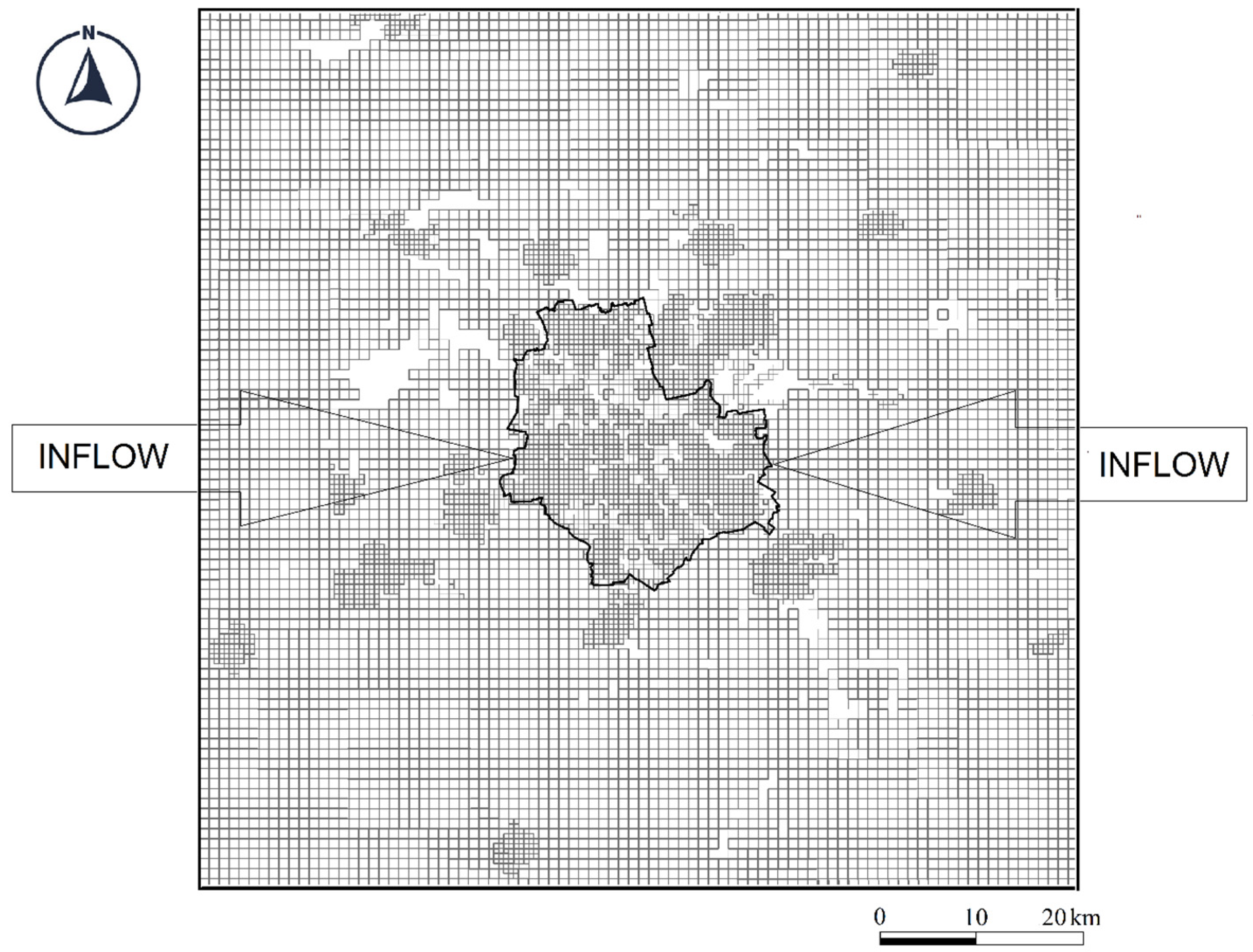
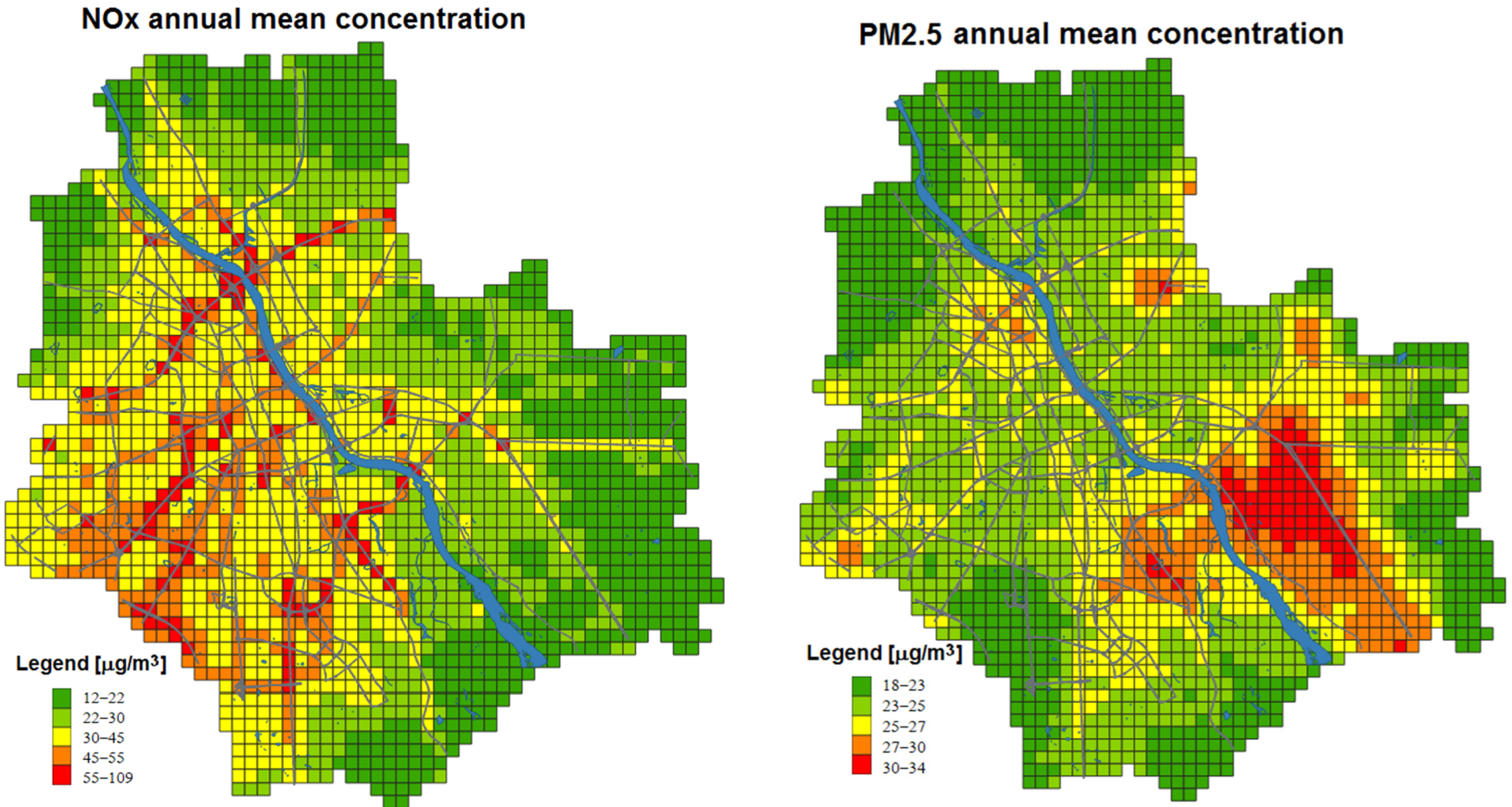
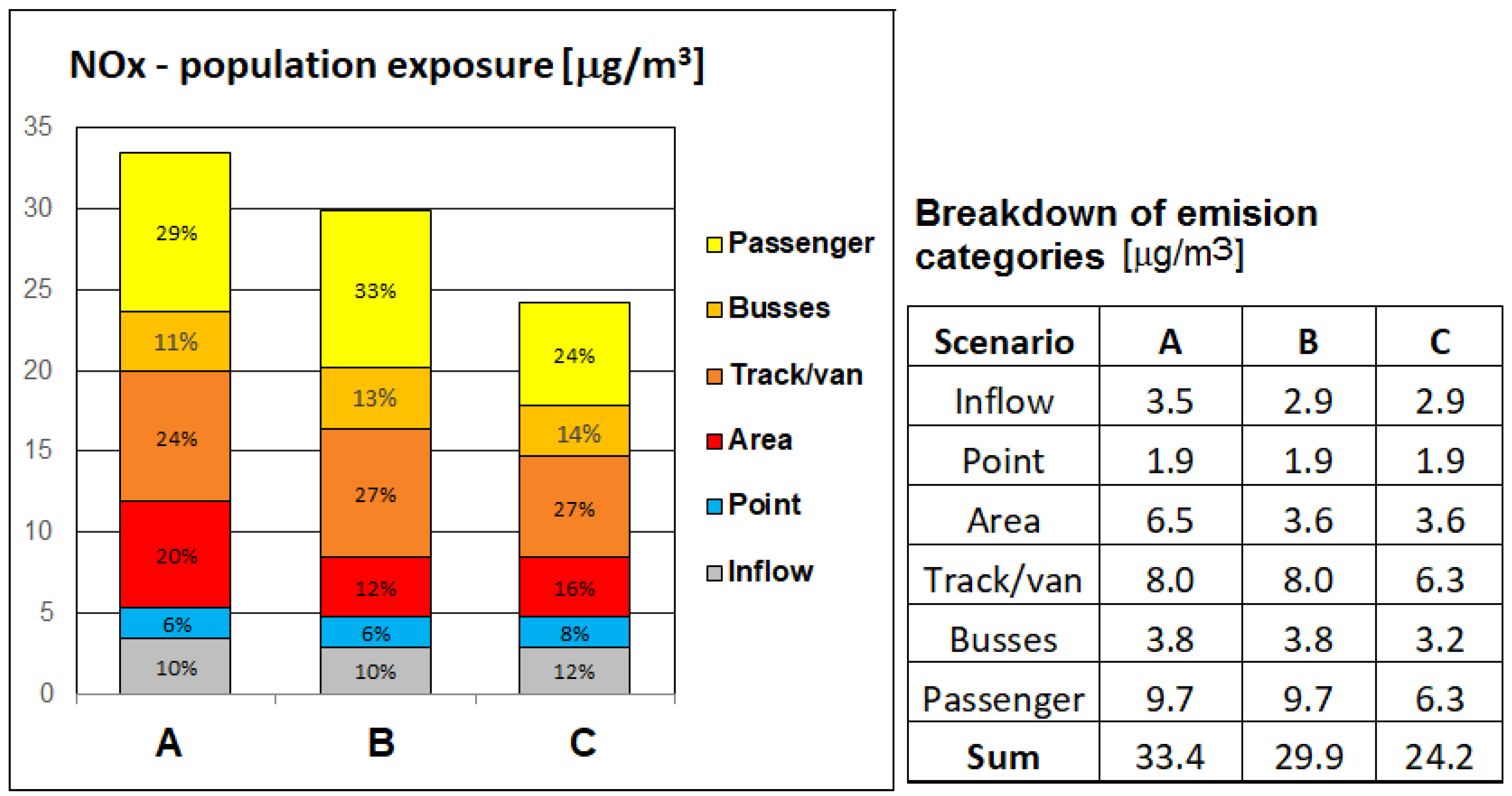
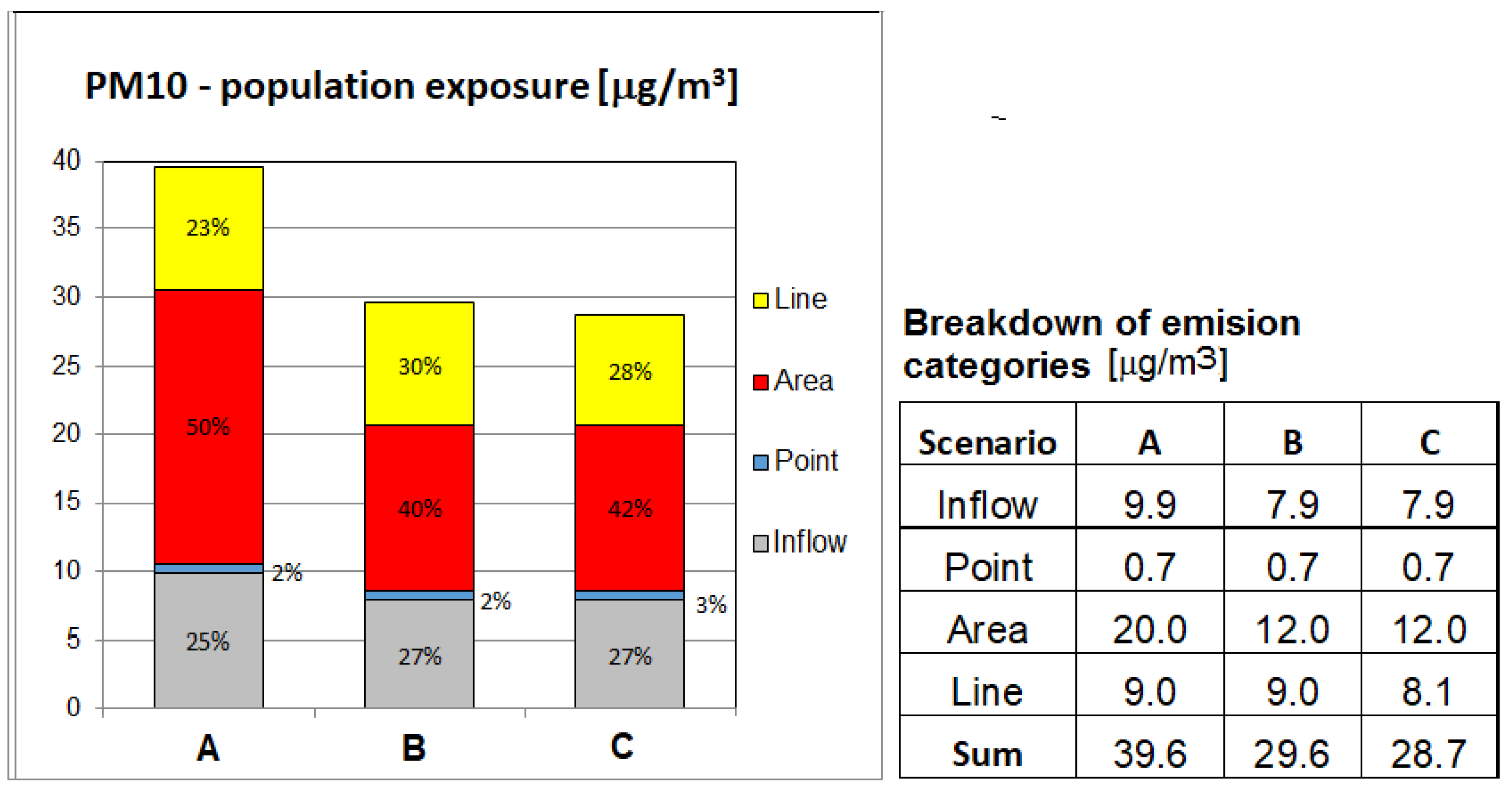
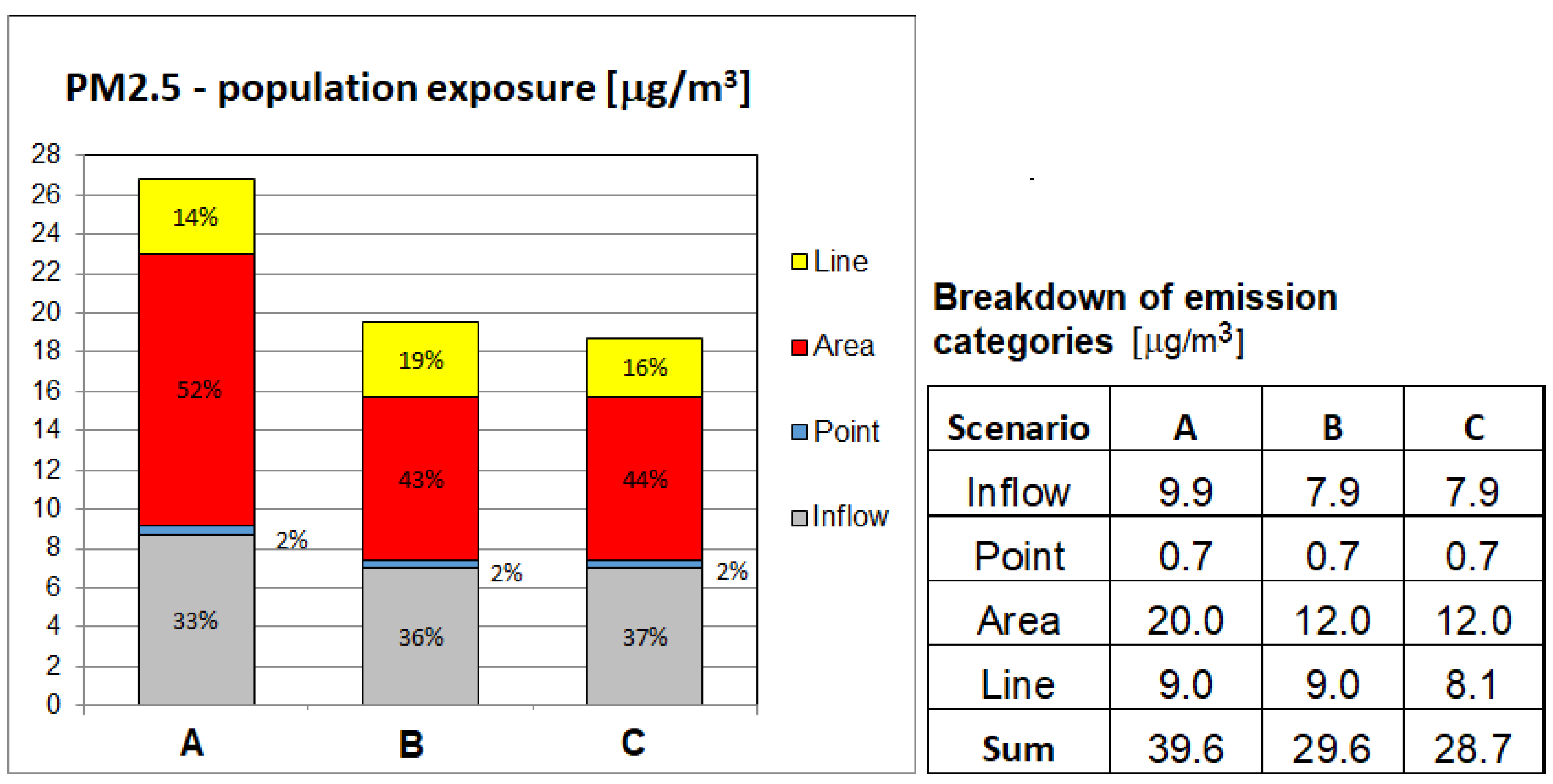
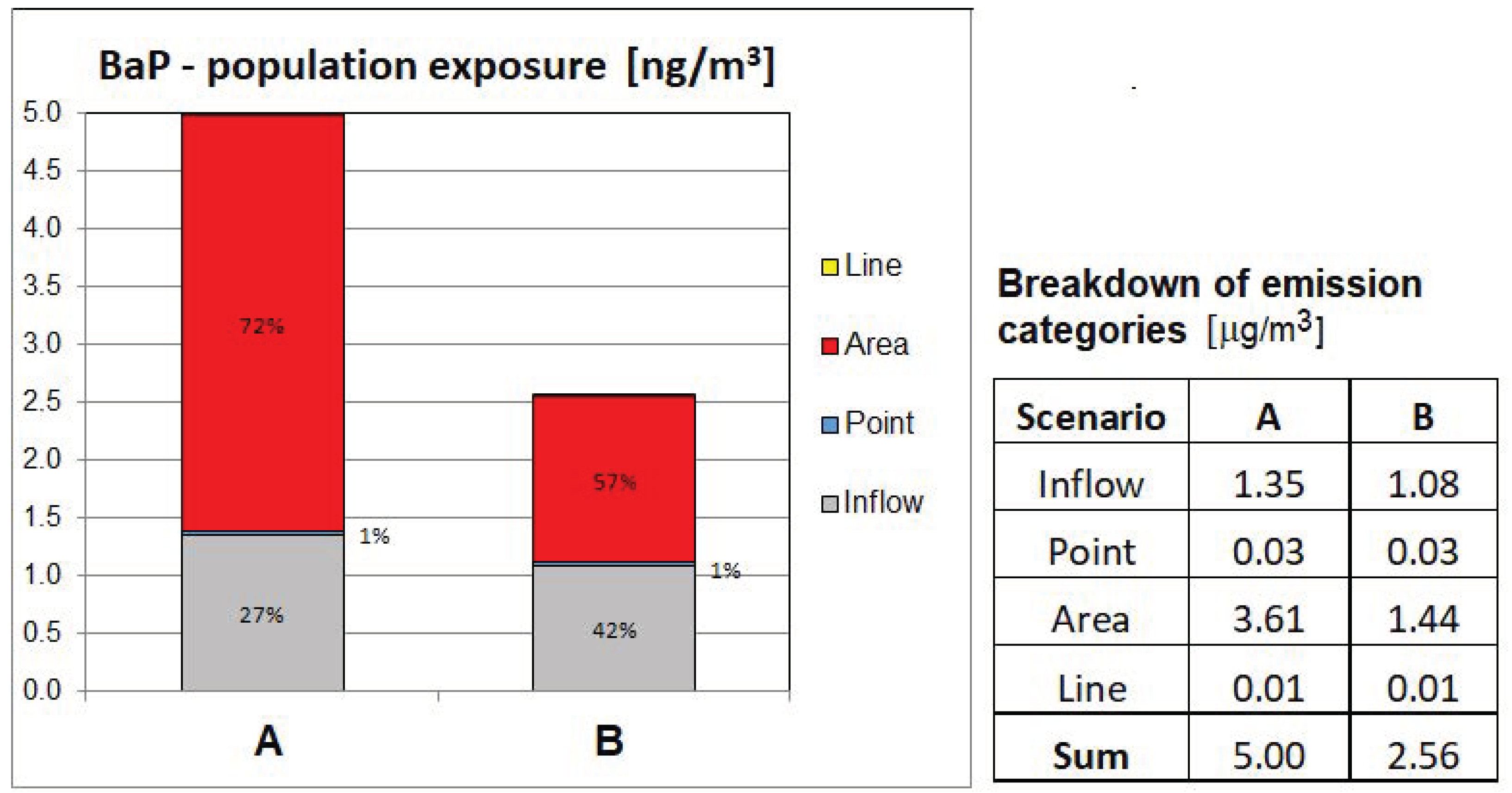
| Euro Norm | Distance [km × 106] | Share [%] | Emiss. Rate [g/km] | Emission [kg × 103] | Share [%] | |
|---|---|---|---|---|---|---|
| Gasoline | E0-E3 | 52,894 | 32% | 0.32 | 17,000 | 19% |
| E4-E6 | 13,684 | 9% | 0.1 | 1368 | 2% | |
| distance | 66,678 | 41% | emission | 18,368 | 21% | |
| Diesel | E0-E3 | 67,895 | 42% | 0.77 | 51,190 | 59% |
| E4-E6 | 26,316 | 16% | 0.65 | 17,105 | 20% | |
| distance | 94,211 | 59% | emission | 68,295 | 79% | |
| TOTAL | 160,789 | 100% | 86,663 | 100% |
Publisher’s Note: MDPI stays neutral with regard to jurisdictional claims in published maps and institutional affiliations. |
© 2022 by the authors. Licensee MDPI, Basel, Switzerland. This article is an open access article distributed under the terms and conditions of the Creative Commons Attribution (CC BY) license (https://creativecommons.org/licenses/by/4.0/).
Share and Cite
Holnicki, P.; Kałuszko, A.; Nahorski, Z. Scenario Analysis of Air Quality Improvement in Warsaw, Poland, by the End of the Current Decade. Atmosphere 2022, 13, 1613. https://doi.org/10.3390/atmos13101613
Holnicki P, Kałuszko A, Nahorski Z. Scenario Analysis of Air Quality Improvement in Warsaw, Poland, by the End of the Current Decade. Atmosphere. 2022; 13(10):1613. https://doi.org/10.3390/atmos13101613
Chicago/Turabian StyleHolnicki, Piotr, Andrzej Kałuszko, and Zbigniew Nahorski. 2022. "Scenario Analysis of Air Quality Improvement in Warsaw, Poland, by the End of the Current Decade" Atmosphere 13, no. 10: 1613. https://doi.org/10.3390/atmos13101613






